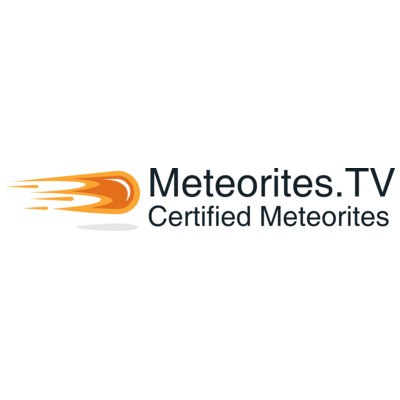H Group (High-Iron)
H Chondrites
Synonyms: olivine-bronzite chondrites, bronzite chondrites, Cronstad-like chondrites
General: The chondrites of the H group are named for the high content of free nickel-iron that is characteristic for the meteorites of this group - the "H" standing for "high iron". H chondrites contain a weight percentage of 25 to 31% total iron whereas only 15 to 19% of the nickel-iron is found in its free, reduced form. Therefore, all H chondrites are attracted to a magnet quite easily. Their type specimen is Cronstad, a witnessed South African chondrite fall from 1877.
Description: Freshly fallen H chondrites show a dull black fusion crust and a light colored interior with abundant sparkling metal flakes dispersed in the grey matrix. Weathered finds mostly show dark brownish interiors, due to oxidation of the metal. The H chondrites belong to petrological types 3 - 7, with a characteristic peak at type 5. More than 4,400 members of this group have been classified as H5, about 2,300 are H6, and about 1,800 are H4. There are only about 250 H3s as well as several rare and heavily brecciated members that contain lithic clasts of more than one petrological type.
Mineralogy: Besides the abundant nickel-iron metal, the primary minerals are olivine and the orthopyroxene bronzite. Therefore the H chondrites have also been called "olivine-bronzite chondrites" or "bronzite chondrites" in the past, but those names are no longer in use.
Origin and Formation: More recent comparisons of the reflectance spectra of H chondrites to the spectra of several main belt asteroids have yielded a probable parent body - the asteroid 6 Hebe. However, Hebe might not be the direct source of the H chondrites but only some sort of ancestor. Hebe probably collided with another asteroid at one time of his history and larger parts of it were dislodged into an elliptical near-Earth orbit. The resulting swarm of NEOs, the children of Hebe, are thought to be the true parents from which the H chondrites are derived.
Members: This large group counts more than 9,000 members, including a lot of probable pairings from the hot deserts of Africa and Asia as well as from the ice fields of Antarctica. Historic witnessed falls include famous meteorites such as Barbotan, Luponnas, Pultusk, or Weston. More recent, but also highly covetted witnessed falls include Gao, Jilin, Juancheng, Peekskill, Portales Valley, Thuate, and Zag - just to name a few.
- Lunar Meteorites
- Martian Meteorites
- Meteorite Classification
-
Buy Meteorites By Classification
- Lunar A
-
Iron Meteorites
- Campo Del Cielo Meteorites For Sale
- Meteor Crater Meteorite
- Meteorites From The Meteor Crater
- IIE Iron Meteorites
- Odessa Meteorite
- Gibeon Meteorite
- Octahedrites
- Hexahedrites
- Ataxites
- Silicated Iron
- Sikhote Alin Meteorite
- IAB Iron Meteorites
- IIAB Iron Meteorites
- IIC Iron Meteorites
- IID Iron Meteorites
- IIF Iron Meteorites
- IIG Iron Meteorites
- IIIAB Iron Meteorites
- IIICD Iron Meteorites
- IIIE Iron Meteorites
- IIIF Iron Meteorites
- IVA Iron Meteorites
- IVB Iron Meteorites
- Ungrouped Iron Meteorites
- Muonionalusta Meteorite
- IC Iron Meteorites for sale
- Canyon Diablo Meteorite
- Henbury
- IIIA Iron Meteorites
- Cape York Meteorite
- Unclassified Iron Meteorites
- Toluca Meteorite
- brenham Meteorite
- Gibeon Meteorites For Sale
- Plessitic Octahedrites
- Glorieta Mountain Iron Meteorite
- Seymchan Meteorite
- Wabar Meteorite
- La Caille Meteorite
- Lunar mare Basalt, lunar B
-
Carbonaceous Chondrites
- Carbonaceous chondrites CB
- Carbonaceous chondrites CI
- Carbonaceous chondrites CO
- Carbonaceous chondrites CM
- Carbonaceous chondrites CV
- Carbonaceous chondrites CR
- Carbonaceous chondrites CK
- Ungrouped Carbonaceous chondrites
- Carbonaceous Chondrites CH
- Carbonaceous Chondrite Grouplet
- Sutter's Mill Meteorite For Sale
-
Pallasites
-
Main Group Pallasites
- Esquel pallasite
- Imilac pallasite
- Fukang Pallasite
- Glorieta Mountain pallasite
- Krasnojarsk pallasite
- Marjalahti Pallasite
- Brahin Pallasite
- Huckitta Pallasite
- Seymchan Pallasite
- Brenham Pallasite
- Admire Pallasite
- Albin Pallasite
- Krasnoyarsk Pallasite
- Springwater Pallasite
- Ahumada Pallasite
- Imilac Meteorite
- Fukang Meteorite
- Krasnojarsk Meteorite
- Eagle Station Pallasites (ESP)
- Pyroxene Pallasites (PXP)
- Pallasites for sale
- Esquel Meteorite
- Eagle Station Meteorite
-
Main Group Pallasites
-
Chondrites
-
Achondrites
- Meteorite Thin Sections
- Stony-Iron Meteorites
- Tektites
- LUN-M, Mingled Mare
- Types of Meteorites
- LUN G (Lunar Gabbro), lunar meteorites
- Moon Meteorites
- pallasite
- Martian Meteorite
- Unique meteorites sold
- Videos of Meteorites
- lunar meteorite hunters
